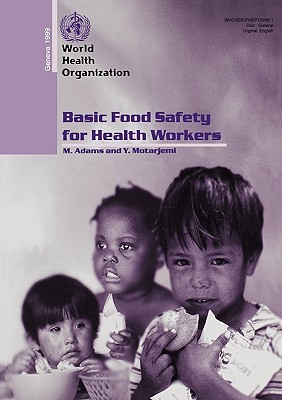
- We will send in 10–14 business days.
- Author: M Adams
- Publisher: World Health Organization
- Year: 1999
- Pages: 116
- ISBN-10: 9241595213
- ISBN-13: 9789241595216
- Format: 21 x 29.7 x 0.7 cm, minkšti viršeliai
- Language: English
- SAVE -10% with code: EXTRA
Reviews
Description
A practical guide to basic principles and practices aimed at reducing the incidence of foodborne illness at both family and community levels. Addressed to health workers and their trainers, the book responds to the magnitude of health problems caused by foodborne illness, particularly in young children, the elderly, and other vulnerable groups. Although all components of food safety are covered, particular emphasis is placed on the hazards posed by the presence of pathogenic microorganisms in food.
The book has seven chapters. The first introduces the problem of foodborne illness, discusses its health and economic consequences, and explains the concepts of infection intoxication and infectious dose. Chapter two focuses on foodborne hazards, gives a detailed account of the many biological, chemical, and physical hazards that can compromise food safety. Against this background, chapter three explains the processes of microbial contamination, growth, and survival as the main causes of outbreaks of foodborne illness. Particular attention is given to factors such as hygiene, temperature, time, nutrient and oxygen requirements, storage, and packaging that carry lessons relevant to safe food preparation and processing. Hazards associated with different foods are considered in the next chapter, which provides a guide to the risks posed by meat and poultry, eggs, milk and dairy products, fish and shellfish, fruits and vegetables, cereals, and bottled waters. Chapter five considers both traditional and modern industrial technologies that can prevent contamination, control microbial growth or remove or kill microorganisms in food. The remaining chapters outline the principles of good hygiene in family food preparation and mass catering, and discuss what health workers can do to alleviate the problem of foodborne illness, particularly in young children. The book concludes with an extensive table setting out basic facts about the epidemiology of over 30 foodborne illnesses.
EXTRA 10 % discount with code: EXTRA
The promotion ends in 21d.05:34:44
The discount code is valid when purchasing from 10 €. Discounts do not stack.
- Author: M Adams
- Publisher: World Health Organization
- Year: 1999
- Pages: 116
- ISBN-10: 9241595213
- ISBN-13: 9789241595216
- Format: 21 x 29.7 x 0.7 cm, minkšti viršeliai
- Language: English English
A practical guide to basic principles and practices aimed at reducing the incidence of foodborne illness at both family and community levels. Addressed to health workers and their trainers, the book responds to the magnitude of health problems caused by foodborne illness, particularly in young children, the elderly, and other vulnerable groups. Although all components of food safety are covered, particular emphasis is placed on the hazards posed by the presence of pathogenic microorganisms in food.
The book has seven chapters. The first introduces the problem of foodborne illness, discusses its health and economic consequences, and explains the concepts of infection intoxication and infectious dose. Chapter two focuses on foodborne hazards, gives a detailed account of the many biological, chemical, and physical hazards that can compromise food safety. Against this background, chapter three explains the processes of microbial contamination, growth, and survival as the main causes of outbreaks of foodborne illness. Particular attention is given to factors such as hygiene, temperature, time, nutrient and oxygen requirements, storage, and packaging that carry lessons relevant to safe food preparation and processing. Hazards associated with different foods are considered in the next chapter, which provides a guide to the risks posed by meat and poultry, eggs, milk and dairy products, fish and shellfish, fruits and vegetables, cereals, and bottled waters. Chapter five considers both traditional and modern industrial technologies that can prevent contamination, control microbial growth or remove or kill microorganisms in food. The remaining chapters outline the principles of good hygiene in family food preparation and mass catering, and discuss what health workers can do to alleviate the problem of foodborne illness, particularly in young children. The book concludes with an extensive table setting out basic facts about the epidemiology of over 30 foodborne illnesses.


Reviews